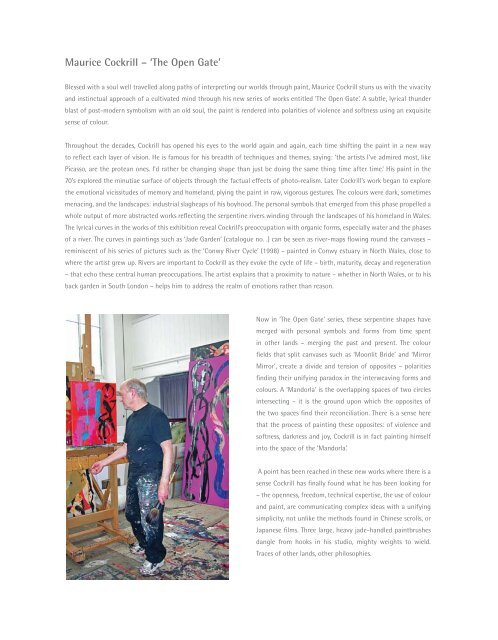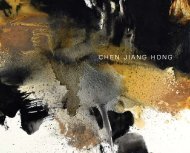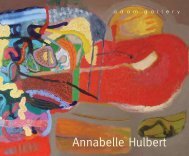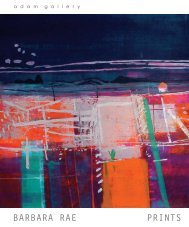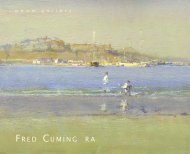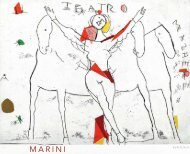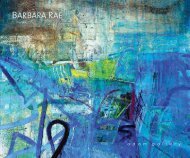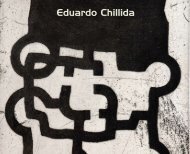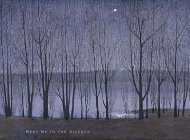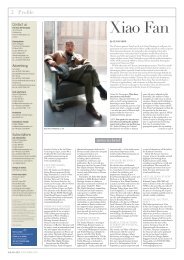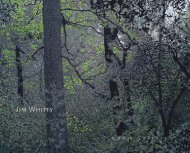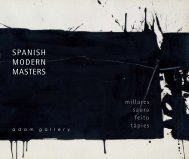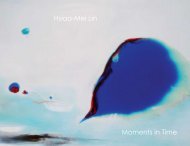'Open Gate' exhibition - pdf catalogue - Adam Gallery
'Open Gate' exhibition - pdf catalogue - Adam Gallery
'Open Gate' exhibition - pdf catalogue - Adam Gallery
You also want an ePaper? Increase the reach of your titles
YUMPU automatically turns print PDFs into web optimized ePapers that Google loves.
Maurice Cockrill – ‘The Open Gate’<br />
Blessed with a soul well travelled along paths of interpreting our worlds through paint, Maurice Cockrill stuns us with the vivacity<br />
and instinctual approach of a cultivated mind through his new series of works entitled ‘The Open Gate’. A subtle, lyrical thunder<br />
blast of post-modern symbolism with an old soul, the paint is rendered into polarities of violence and softness using an exquisite<br />
sense of colour.<br />
Throughout the decades, Cockrill has opened his eyes to the world again and again, each time shifting the paint in a new way<br />
to reflect each layer of vision. He is famous for his breadth of techniques and themes, saying: ‘the artists I’ve admired most, like<br />
Picasso, are the protean ones. I’d rather be changing shape than just be doing the same thing time after time.’ His paint in the<br />
70’s explored the minutiae surface of objects through the factual effects of photo-realism. Later Cockrill’s work began to explore<br />
the emotional vicissitudes of memory and homeland, plying the paint in raw, vigorous gestures. The colours were dark, sometimes<br />
menacing, and the landscapes: industrial slagheaps of his boyhood. The personal symbols that emerged from this phase propelled a<br />
whole output of more abstracted works reflecting the serpentine rivers winding through the landscapes of his homeland in Wales.<br />
The lyrical curves in the works of this <strong>exhibition</strong> reveal Cockrill’s preoccupation with organic forms, especially water and the phases<br />
of a river. The curves in paintings such as ‘Jade Garden’ (<strong>catalogue</strong> no. .) can be seen as river-maps flowing round the canvases –<br />
reminiscent of his series of pictures such as the ‘Conwy River Cycle’ (1998) – painted in Conwy estuary in North Wales, close to<br />
where the artist grew up. Rivers are important to Cockrill as they evoke the cycle of life – birth, maturity, decay and regeneration<br />
– that echo these central human preoccupations. The artist explains that a proximity to nature – whether in North Wales, or to his<br />
back garden in South London – helps him to address the realm of emotions rather than reason.<br />
Now in ‘The Open Gate’ series, these serpentine shapes have<br />
merged with personal symbols and forms from time spent<br />
in other lands – merging the past and present. The colour<br />
fields that split canvases such as ‘Moonlit Bride’ and ‘Mirror<br />
Mirror’, create a divide and tension of opposites – polarities<br />
finding their unifying paradox in the interweaving forms and<br />
colours. A ‘Mandorla’ is the overlapping spaces of two circles<br />
intersecting – it is the ground upon which the opposites of<br />
the two spaces find their reconciliation. There is a sense here<br />
that the process of painting these opposites: of violence and<br />
softness, darkness and joy, Cockrill is in fact painting himself<br />
into the space of the ‘Mandorla’.<br />
A point has been reached in these new works where there is a<br />
sense Cockrill has finally found what he has been looking for<br />
– the openness, freedom, technical expertise, the use of colour<br />
and paint, are communicating complex ideas with a unifying<br />
simplicity, not unlike the methods found in Chinese scrolls, or<br />
Japanese films. Three large, heavy jade-handled paintbrushes<br />
dangle from hooks in his studio, mighty weights to wield.<br />
Traces of other lands, other philosophies.


